After three years old, the age is calculated with a calculator using the formula:
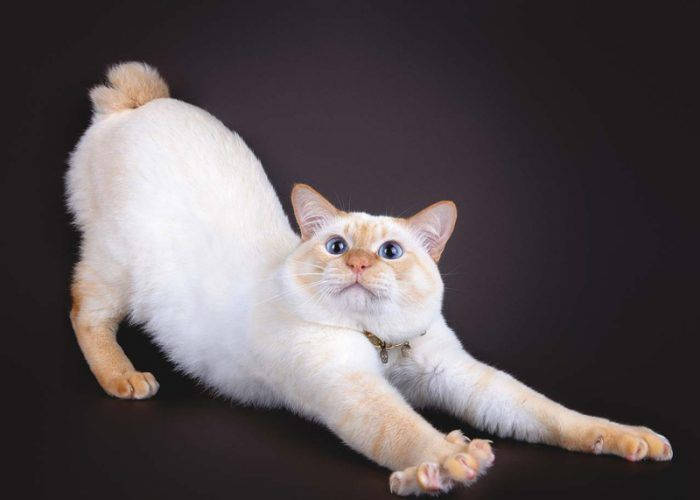
- Who is older: the cat or the owner
- Stages of a cat's life
- Physiological signs of a cat's age
- How to tell exactly how old a cat is
- How old is a cat by human standards
- Ratio of age of a cat to a human
- First method
- The second method
- The third method
- Is it possible to increase a cat's lifespan
- Age of a cat by human standards
- How old are cats and how to calculate their age
- What does the longevity of cats depend on
Who is older: the cat or the owner
Often I hear that 1 cat year is equal to 7 human years, but today I would like to take a closer look at this information. In fact, the concept of a cat's age is much broader and with a closer look you will be able to relate the pet's age to a human's age more accurately.
A cat's entire life span cannot be accurately calculated by simply multiplying each year of life by 7. And for the period up to a year, this calculation does not fit at all. It is difficult to relate a cat's development to that of a human, so for a better understanding of age it is better to use tables showing how each month of the cat's life corresponds to a human.
Age from one to three years is also difficult to understand by adding a certain number. The only period for which such a calculation can be used is between the ages of 3 and 7, but even then the characterization will be inaccurate.
Below I give you a sample table which will allow you to correlate the age of your pet with the age of a human.
In my opinion, this table accurately enough reflects the ratio of the age of the cat to the human. Photo by the author
The life path of cats, as well as that of humans, can be divided into several stages:
The period of early childhood Characterized by active growth, readiness for long and active play, lasts until about six months of age.
Then, after the onset of puberty, comes youth . The growth of the animal slows down a little, but activity and willingness to play is maintained and even increased. This period lasts up to 2 years.
From 2 to 7 years, the cat is considered an adult. At this time, the cat is physically active, it has received the necessary skills and education. She uses past experiences in her actions.
In adulthood, which lasts until the age of 11 – 12, There may be a decrease in activity, the cat is more attentive to what is going on. Her actions become less precise and quicker.
Older cats are considered to be at the age of 11 (12) to 15 years. The cat's sleep duration increases, activity decreases significantly, and changes in temperament occur. (You can read about age-related changes in a cat's behavior here )
Stages of a cat's life
- Childhood (from birth to 6 months) – the stage of rapid growth and development up to puberty.
- Youth (6 months to 2 years) – preparation for adult life; the growth continues, but its pace slows down.
- Ages at their prime (from 2 to 7 years) – peak of physical and mental activity: your cat has strong bones, teeth and a fine, healthy coat.
- Maturity (7 to 11 years) – a slight decrease in activity.
- Older age (11 to 15 years) – gradual loss of vitality, which affects the condition of the coat, claws and teeth; occasional health problems.
- Old age (more than 15 years) – decreased activity, increased sleep duration, greater risk of illness.
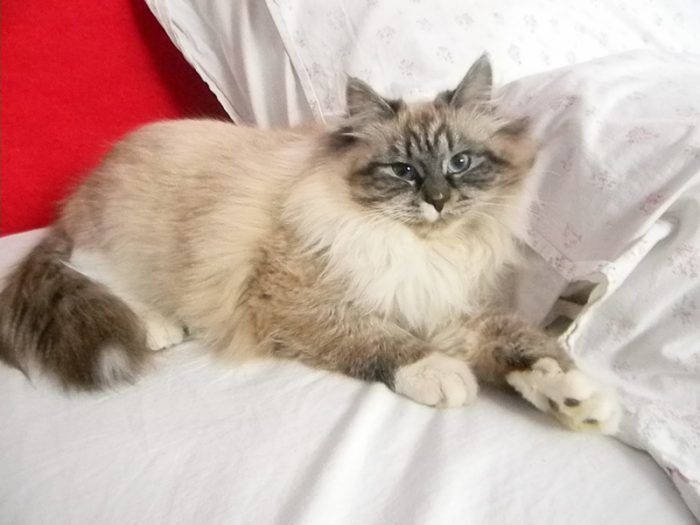
Physiological signs of a cat's age
There are times when an animal comes to owners unaware of how old it is – for example, from a shelter or straight from the street. In such cases, veterinarians pay attention to the condition of the animal's teeth to determine its approximate age:
- At 1 month of age, a kitten has all its milk teeth.
- By 6 months of age, they have completely changed to molars.
- By the middle of the second year of life, the central middle incisors slightly wear down.
- By the age of two and a half, the lower middle incisors begin to wear down.
- At the age of three and a half, this also occurs in the central upper jaw teeth.
- After another year, it happens to the middle teeth.
- By the age of five, the canines begin to suffer.
- By six, the outermost upper incisors.
- By nine, all the teeth of the lower jaw were ground down.
- And by ten, the upper jaw.
- By twelve, the central incisors may begin to fall out.
- Some cats lose most of their teeth by age fifteen.
These parameters greatly depend on breed, heredity, and health. One should also take into account what and how the cat eats, what kind of environment it lives in, and whether it receives vitamin and mineral supplements, which help protect the teeth from age-related changes.
How to tell exactly how old a cat is
To find out exactly how old a cat is, it's best to show it to a veterinarian. But you can determine age on your own by checking the telltale signs. One of the most reliable indicators is the condition of her teeth.
Teeth won't help you determine the exact date of birth of your four-legged friend, but they are still a great indicator of age. Key milestones in dental development:
- A kitten's first teeth appear two to four weeks after birth.
- It takes about four months to get permanent white teeth.
- Yellow spots, also known as tartar, on some teeth may mean that the cat is one to two years old.
- If spots appear on all of the teeth, the cat is probably three to five years old.
- Missing teeth are usually a sign of a solid age – 10 to 15 years old.
But keep in mind that some cats may have worse teeth than their congeners, regardless of age.
Now you know how many years a cat lives by human standards. But it could be more: give it the right food, lots of good care, and always check up on it at the vet.
You'll find a wide range of products for your pets in our catalog.
How old is a cat by human standards
Every cat lover knows that the purring of his favorite cat can prevent many diseases, he also knows that her antennae help her determine whether she can get through the hole. It is not a secret for many that in his life favorite kitty can give birth to about a hundred kittens. Many of us also know that no cat will purr to a cat and vice versa, because this sound is intended only for its owner.
Have you ever wondered how old your cat is by human standards? After all, quite often it happens that our pets begin to behave rather arrogantly with age and agree to be petted with more indulgence, have you ever thought that this is due to the fact that when you grow up a year, your kitty is gaining almost an extra decade and with age it treats you like a brother or a young tomboy.
Our online calculator will help you calculate how old your pet or pets are by human standards. All you have to do is state her age, down to the months.
Ratio of age of a cat to a human
Experts name three techniques for comparing the life periods of humans and cats. Unfortunately, none of them is considered absolutely accurate, so the age of a cat by human standards is always only an approximation.
First method
The reference point is 1 year. This period is the time of puberty of the animal. Such an age correlates with the 16 years of a human. Another milestone is 2 years, at which time the formation of the character and habits of the pet ends. This occurs at 24 years by human standards. After 3 years, the degree of maturity of the pet is determined by the formula:
For example, your cat is 6 years old. So, subtract two (you get four), multiply by four (you get 16), and then add twenty-four. It turns out that a six-year-old cat is exactly 40 years old by human standards.
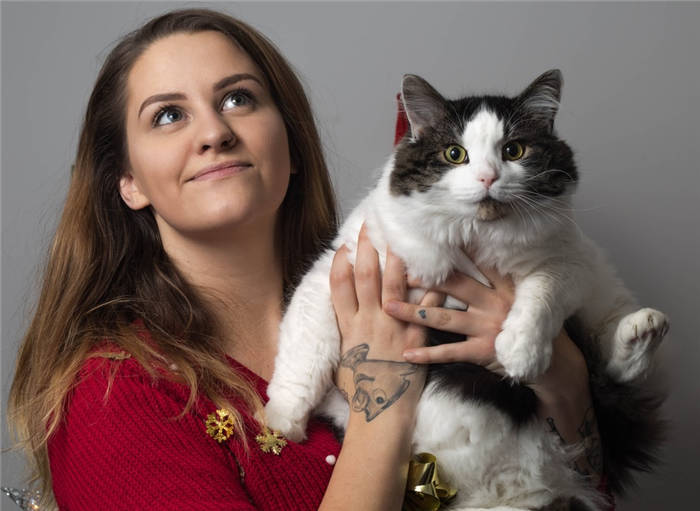
The second method
Another method is to calculate the number of years of each of the three periods of life. This method is considered more accurate than the previous one because of the detailed calculations. You can determine the degree of maturity by the following formulas:
The third method
This method has a scientific basis and was developed by veterinarians together with zoologists. It is based on an index that takes into account the intellectual, psychological and physiological level of development, which translates feline age to human age in the table.
Despite such a detailed table, it should be remembered that an exact comparison of two fundamentally different biological species is almost impossible. Feline age by human standards can have fluctuations. The rate of development of human and animal organisms has few similar characteristics. Here we should also take into account the difference in breeds and gender differences.
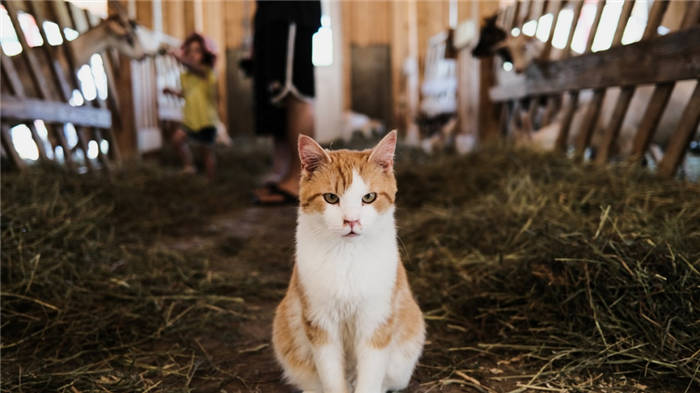
Is it possible to increase a cat's lifespan
Every owner dreams that a furry family member pleases him as long as possible. And in his power to do everything to ensure that the cat will live 15, and even 20 years. What will prolong the life of his favorite four-legged man:
- Annual vaccinations. . A kitten is vaccinated in the first 2-3 months of life and then every year repeats the procedure. This will protect your cat from the worst viruses, including a high fatality rate, both at home and on the street.
- Routine checkups at the vet . Non-breeds get less disease, so they can be seen at the vet during their vaccinations once a year – just ask the vet for it. Pedigreed animals and animals with chronic illnesses require more frequent visits to the vet – the vet will tell you how often.
- Spaying and neutering . If you are not planning to breed kittens, be sure to spay your pet – this will help avoid many problems, including genitourinary diseases and mental disorders.
- Pay attention to any changes in your pet's behavior . Has your kitty become thirsty? Has she stopped sleeping in her favorite chair? Limps? Has it begun to produce strange discharge? Even these little things require careful attention from the owner. Call the vet if you suspect anything, and he or she will tell you whether your pet needs to be taken to a clinic or if you can keep an eye on him or her at home.
- Cleanliness – a guarantee of health. Cats lick themselves, but not enough to maintain hygiene. For example, long-haired breeds cannot cope with the care of a luxurious coat, and it must be combed regularly – so that no parasites or skin diseases appear. Cat bowls of food and water should be thoroughly washed, litter trays disinfected and bedding washed.
- Nutrition should be maintained at a high level. It is not so important what you feed your cat – as long as it is suitable for the selected diet. A young cat will benefit from both straight food and quality dry food. But kittens and older individuals require a special menu, which cannot be cheap. Therefore, before getting a cat think about the fact that in its old age it will require more expenses than in its youth.
- Treat the cat as a family member. . Consider the pet's personality and needs. If she does not like being left alone it is not a good idea to leave her in the apartment all day. And vice versa – if the cat likes solitude, respect its personal space. There are many such points, and if you do not pay attention to the psychological state of the animal, it will be constantly sick and will not live too long.
Age of a cat by human standards
It happens that a seemingly mature and large-sized pet behaves like an unexperienced kitten who has only recently begun to crawl out of the nest and is actively learning about the world. Maybe he's still a baby (a teenager). I wonder how old he is by human standards.
There can be no serious scientific research on this topic – the growth and development of each species of living beings is unique. However, we do not aim to establish how correct it is to compare the age of a cat and a human, and we are not going to prove that all comparative tables will be to some extent tentative.
Cats have definite periods of life too: childhood, adolescence, maturity and (if we are lucky) old age. I must say that the timing of maturation in cats (especially purebreds) varies greatly. There are breeds that reach full growth and development by 3-4 years of age.
In general, the age of a cat in terms of human years looks like this.
At the age of three months, a kitten can separate from its mother without harm to its physical and mental health.
How old are cats and how to calculate their age
How long do cats live? On average, a domestic cat lives 12-15 years. Homeless and street animals live an average of 3-5 years. There is virtually no gender difference in the life expectancy of cats and cats.
How long do neutered cats live? Neutered cats live 2-3 years longer if they don't have genetic diseases. Neutered cats also live longer.
How long do British cats live? British cats are among the long-living cats. They live an average of 15 years, and some pets live more than 20 years. Olesya Pukhova, author of the book "British Shorthair Cats," specifies that the British grow up very slowly. Only at the age of 5 years they reach their full maturity.
How long do sphynx cats live? Sphynx cats have poor health, so they do not live long. Their lifespan reaches an average of 9-14 years, under favorable conditions – 15-18 years.
Cats, like people, have their own periods of life: childhood, adolescence, formation, reproductive age, old age. The stages of their lives are as follows:
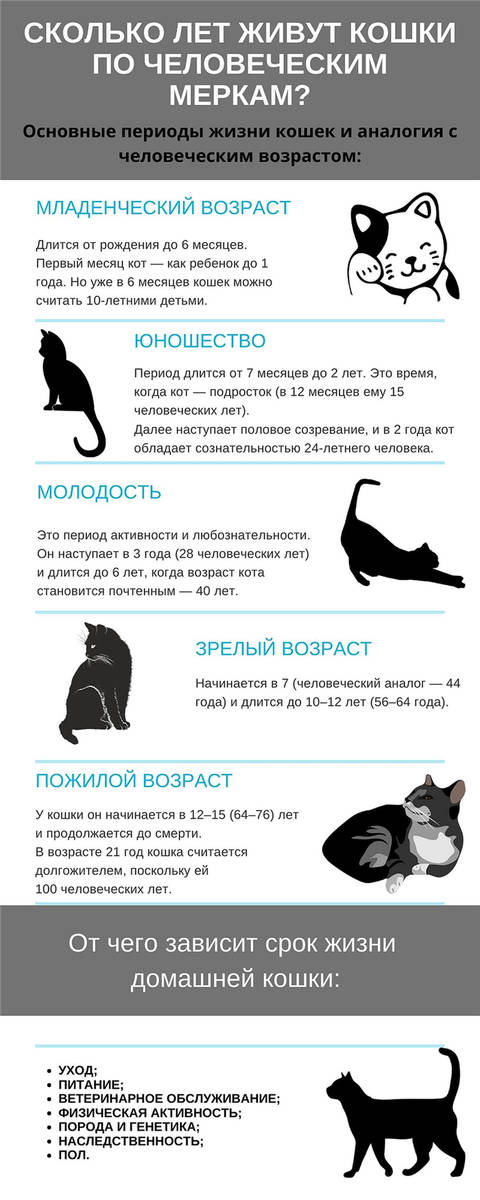
- Kittens are completely dependent on mother's milk for 8-10 weeks. Then they switch to other foods and become independent.
- Puberty occurs in cats at 8-10 months, in cats at 6-8 months.
- Reproductive age in cats lasts throughout their lives. There is an increased risk of death when older cats give birth.
How do you count a cat's age? If you compare a cat's age to a human life, 1 human year equates to 7 cat years. Cats age faster in their early years, so the "7 year rule" does not reflect the actual picture. As a result, a cat's life by human standards looks like this:
- In 1 year, a cat lives almost 15 years of human life and goes from childhood to adolescence.
- During the second year of life, the cat reaches sexual maturity and begins to reproduce offspring (puberty and the beginning of reproductive age), which equates to 24 years of human life.
- Starting from the third year of life, cats can add 4 years of human life each year.
- A cat reaches old age at 11-12 years, which equates to 60-64 years of human life.
- If a cat lives more than 12 years, it passes into old age and reaches the advanced human age of 75-90 years. Long-lived cats that have lived more than 20 years may claim to be 100 years old in humans.
What does the longevity of cats depend on
The longevity of cats depends on many factors. These include the cat's breed, lifestyle (domestic or stray), health, nutrition, and care.
Pedigree domestic cats often live shorter lives than mongrels. It all depends on immunity and resistance to hereditary and viral diseases. Breeds of long-living cats include Maine Coon, Bengal, Russian Blue, Siamese, Burmese, and Ragdoll, which live an average of 20-23 years.
If the cat lived in the house and then ended up on the street, its life is in mortal danger. Such a cat will not be able to survive in extreme conditions, getting food and warmth. The only salvation is to get closer to a human near a house or a cafe.
The life of street cats is subject to other dangers. They are not afraid of hunger and cold, but can die under the wheels of a car or other force majeure. Many street animals die without vaccination against viral diseases and invasion of ectoparasites.
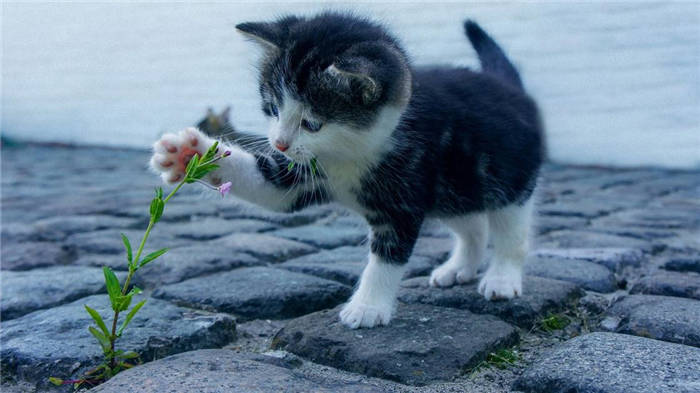
Dreaming of a long-lived domestic cat, create all conditions for a better quality of life of the cat:
- Feeding. Choose a suitable diet with sufficient vitamins, proteins and trace elements. Do not mix dry and natural food. Feed the animals on a schedule, do not overfeed. Give kittens four to six meals a day, adult cats transfer after one year to two meals a day.
- Home environment. Cats are social animals. They love affection, care and become attached to people. The animal should not be left alone for long periods of time, handed over to other people. Stress reduces the cat's immunity and leads to its early death.
- Care. Kittens from childhood are accustomed to order and cleanliness. A cat should have its own place, a scratching post, bowls for food and water, a litter box, or two, as advised by Rosvita Berger, author of "Raising Cats and Understanding Their Behavior. Cats are brushed, bathed occasionally, have their nails shined, and have their ears, eyes and teeth cleaned.
- Health. Cats must be vaccinated and have preventive check-ups at the vet to make sure they don't miss any health problems. Gill Deborah , author of the book "Cats: a mini-encyclopedia", advises first of all to vaccinate cats against dangerous diseases – enteritis and influenza. The animal is given special funds against worms and ectoparasites. If you do not plan to breed kittens, be sure to spay the cat and neuter the cat.






